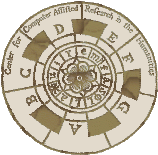Musical Information (Mus 253/CS 275A)
Introduction to the Humdrum Toolkit
|

|
Humdrum
[because of the wealth of material about humdrum generated by its author
David Huron and by Craig Sapp, much material in this lecture can't escape
being at least inspired in some way by those sources. Acknowlegement is
presented whenever direct use of such material occurs]
"Humdrum is a general-purpose software system intended to assist music
researchers. " (Humdrum Online Guide)
Main components: syntax (i.e. kern) and tools or command line programs
(i.e. humdrum, transpose).
Command Reference:
http://dactyl.som.ohio-state.edu/Humdrum/commands
File format
Humdrum files are text files with data grouped in rows and tab separated
columns. Every column must have a 'header' consistent of a word preceded
by two asterisks (**column) and must be terminated with an asterisk and
a hyphen (*-). One of the most common representations is **kern which
has a standardized format for pitch height values, durations, and other
common music notation items.
Humdrum Syntax http://csml.som.ohio-state.edu/Humdrum/guide05.html
Kern http://csml.som.ohio-state.edu/Humdrum/representations/kern.html
Obtaining Information from Humdrum files
Many questions can be answered through simple regular expression search,
followed by counting or classification of some sort; in some cases,
modification of files is also necessary, and some way of summarizing
results can be useful too.
Typical questions are some kind of variation of the following (Humdrum
News #1):
How many different types of _____ are there? What is the most/least
common _____? What is the frequency of occurrence for various
_____s?
Example
**foo **foo 1 *foo
A *- 1 *-
B A 3 A
A sort A uniq -c 2 B rid (humdrum command) can be used to
A A 1 C ignore certain intrepretations.
C B
B B The whole process can be piped (assuming the
*- C initial data exists in a file named foo)
rid -GLId foo | sort | uniq -c > inventory.foo (exp#1)
What if data appears in different columns?
**foo **bar 1 A A
A G 2 A G extract (humdrum command) allows
B G 2 B G to treat each column independently
A G exp#1 1 C G (assume initial data in file foobar)
A A
C G extract -i '**foo' foobar | exp#1
B G extract -i '**bar' foobar | exp#1
*- *- or
extract -i '**foo' foobar > justfoo
extract -i '**bar' foobar > justbar
resulting in
**foo
A
B
A
A
C
B
*- 4 A
**bar rid -GLId foobar.cat | sort | uniq -c 2 B
G 1 C
G 5 G
G
A
G
G
*-
Exercises
Now together with the command 'census', let's answer some typical questions:
- How many measures are there in Corelli's Opus 1, No. 11, first movement?
- How many notes are there in the oboe part from the first movement of Bach's
Brandenburg Concerto No. 2 (BWV 1047)? Should the oboe player be payed more
or less than the cello players?
- Which Brandenburg Concerto contains a horn part? Which movements from this
concerto don't use the horn?
- Which Brandenburg Concerto contains a trumpet part? How long is the longest
note played by the trumpet? How long is the shortest note played by the
trumpet?
- In Brandenburg Concerto No. 3, which movement contains the greatest number of
notes in the string parts?
see files in /usr/ccarh/humdrum/scores/
answers.
Rodrigo Segnini
Revised: 3 Mar 2005
|
